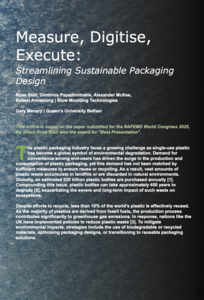
The plastic packaging industry faces a growing challenge as single-use plastic has become a global symbol of environmental degradation. Demand for convenience among end-users has driven the surge in the production and consumption of plastic packaging, yet this demand has not been matched by sufficient measures to ensure reuse or recycling. As a result, vast amounts of plastic waste accumulate in landfills or are discarded in natural environments. Globally, an estimated 525 billion plastic bottles are purchased annually [1]. Compounding this issue, plastic bottles can take approximately 450 years to degrade [2], exacerbating the severe and long-term impact of such waste on ecosystems.
Despite efforts to recycle, less than 10% of the world’s plastic is effectively reused. As the majority of plastics are derived from fossil fuels, the production process contributes significantly to greenhouse gas emissions. In response, nations like the UK have implemented policies to reduce plastic waste [3]. To mitigate environmental impacts, strategies include the use of biodegradable or recycled materials, optimising packaging designs, or transitioning to reusable packaging solutions.
This article appeared in the October 2025 Issue of BENCHMARK.



